[English] 日本語
 Yorodumi
Yorodumi- PDB-6ygj: small-molecule stabilizer of 14-3-3 and the Carbohydrate Response... -
+ Open data
Open data
- Basic information
Basic information
| Entry | Database: PDB / ID: 6ygj | |||||||||||||||
|---|---|---|---|---|---|---|---|---|---|---|---|---|---|---|---|---|
| Title | small-molecule stabilizer of 14-3-3 and the Carbohydrate Response Element Binding Protein (ChREBP) protein-protein interaction | |||||||||||||||
 Components Components |
| |||||||||||||||
 Keywords Keywords | STRUCTURAL PROTEIN / 14-3-3 / Stabilizer / protein-protein interaction / ChREBP / small molecule | |||||||||||||||
| Function / homology |  Function and homology information Function and homology informationcarbohydrate response element binding / glucose mediated signaling pathway / AMPK inhibits chREBP transcriptional activation activity / PKA-mediated phosphorylation of key metabolic factors / PP2A-mediated dephosphorylation of key metabolic factors / positive regulation of transcription from RNA polymerase II promoter by glucose / Tristetraprolin (TTP, ZFP36) binds and destabilizes mRNA / Butyrate Response Factor 1 (BRF1) binds and destabilizes mRNA / ChREBP activates metabolic gene expression / MTOR signalling ...carbohydrate response element binding / glucose mediated signaling pathway / AMPK inhibits chREBP transcriptional activation activity / PKA-mediated phosphorylation of key metabolic factors / PP2A-mediated dephosphorylation of key metabolic factors / positive regulation of transcription from RNA polymerase II promoter by glucose / Tristetraprolin (TTP, ZFP36) binds and destabilizes mRNA / Butyrate Response Factor 1 (BRF1) binds and destabilizes mRNA / ChREBP activates metabolic gene expression / MTOR signalling / positive regulation of fatty acid biosynthetic process / ARMS-mediated activation / negative regulation of oxidative phosphorylation / SHOC2 M1731 mutant abolishes MRAS complex function / Gain-of-function MRAS complexes activate RAF signaling / Rap1 signalling / Signaling by Hippo / vacuolar membrane / triglyceride homeostasis / negative regulation of G protein-coupled receptor signaling pathway / negative regulation of protein import into nucleus / Frs2-mediated activation / protein phosphatase inhibitor activity / DNA-binding transcription activator activity / lipid biosynthetic process / negative regulation of signal transduction by p53 class mediator / protein kinase inhibitor activity / mTORC1-mediated signalling / Regulation of localization of FOXO transcription factors / anatomical structure morphogenesis / Activation of BAD and translocation to mitochondria / phosphoserine residue binding / fatty acid homeostasis / positive regulation of insulin secretion involved in cellular response to glucose stimulus / protein targeting / Chk1/Chk2(Cds1) mediated inactivation of Cyclin B:Cdk1 complex / positive regulation of lipid biosynthetic process / SARS-CoV-2 targets host intracellular signalling and regulatory pathways / energy homeostasis / RHO GTPases activate PKNs / SARS-CoV-1 targets host intracellular signalling and regulatory pathways / transcription repressor complex / Transcriptional and post-translational regulation of MITF-M expression and activity / protein sequestering activity / positive regulation of glycolytic process / TP53 Regulates Metabolic Genes / Translocation of SLC2A4 (GLUT4) to the plasma membrane / phosphoprotein binding / RAF activation / Signaling by high-kinase activity BRAF mutants / MAP2K and MAPK activation / DNA-binding transcription repressor activity, RNA polymerase II-specific / histone deacetylase binding / Negative regulation of MAPK pathway / Signaling by RAF1 mutants / Signaling by moderate kinase activity BRAF mutants / Paradoxical activation of RAF signaling by kinase inactive BRAF / Signaling downstream of RAS mutants / Signaling by BRAF and RAF1 fusions / intracellular protein localization / melanosome / glucose homeostasis / DNA-binding transcription activator activity, RNA polymerase II-specific / transcription regulator complex / DNA-binding transcription factor binding / RNA polymerase II-specific DNA-binding transcription factor binding / DNA-binding transcription factor activity, RNA polymerase II-specific / cadherin binding / RNA polymerase II cis-regulatory region sequence-specific DNA binding / DNA-binding transcription factor activity / protein heterodimerization activity / protein domain specific binding / focal adhesion / negative regulation of DNA-templated transcription / positive regulation of cell population proliferation / regulation of DNA-templated transcription / regulation of transcription by RNA polymerase II / chromatin / positive regulation of DNA-templated transcription / protein-containing complex binding / perinuclear region of cytoplasm / enzyme binding / signal transduction / positive regulation of transcription by RNA polymerase II / DNA binding / extracellular exosome / nucleoplasm / identical protein binding / nucleus / membrane / cytosol / cytoplasm Similarity search - Function | |||||||||||||||
| Biological species |  Homo sapiens (human) Homo sapiens (human) | |||||||||||||||
| Method |  X-RAY DIFFRACTION / X-RAY DIFFRACTION /  SYNCHROTRON / SYNCHROTRON /  MOLECULAR REPLACEMENT / Resolution: 2.07 Å MOLECULAR REPLACEMENT / Resolution: 2.07 Å | |||||||||||||||
 Authors Authors | Ottmann, C. / Visser, E.J. | |||||||||||||||
| Funding support |  Netherlands, Netherlands,  Germany, 4items Germany, 4items
| |||||||||||||||
 Citation Citation |  Journal: Nat Commun / Year: 2020 Journal: Nat Commun / Year: 2020Title: Structure-based evolution of a promiscuous inhibitor to a selective stabilizer of protein-protein interactions. Authors: Sijbesma, E. / Visser, E. / Plitzko, K. / Thiel, P. / Milroy, L.G. / Kaiser, M. / Brunsveld, L. / Ottmann, C. | |||||||||||||||
| History |
|
- Structure visualization
Structure visualization
| Structure viewer | Molecule:  Molmil Molmil Jmol/JSmol Jmol/JSmol |
|---|
- Downloads & links
Downloads & links
- Download
Download
| PDBx/mmCIF format |  6ygj.cif.gz 6ygj.cif.gz | 201 KB | Display |  PDBx/mmCIF format PDBx/mmCIF format |
|---|---|---|---|---|
| PDB format |  pdb6ygj.ent.gz pdb6ygj.ent.gz | 162.3 KB | Display |  PDB format PDB format |
| PDBx/mmJSON format |  6ygj.json.gz 6ygj.json.gz | Tree view |  PDBx/mmJSON format PDBx/mmJSON format | |
| Others |  Other downloads Other downloads |
-Validation report
| Summary document |  6ygj_validation.pdf.gz 6ygj_validation.pdf.gz | 992.1 KB | Display |  wwPDB validaton report wwPDB validaton report |
|---|---|---|---|---|
| Full document |  6ygj_full_validation.pdf.gz 6ygj_full_validation.pdf.gz | 1001.5 KB | Display | |
| Data in XML |  6ygj_validation.xml.gz 6ygj_validation.xml.gz | 21.5 KB | Display | |
| Data in CIF |  6ygj_validation.cif.gz 6ygj_validation.cif.gz | 28.7 KB | Display | |
| Arichive directory |  https://data.pdbj.org/pub/pdb/validation_reports/yg/6ygj https://data.pdbj.org/pub/pdb/validation_reports/yg/6ygj ftp://data.pdbj.org/pub/pdb/validation_reports/yg/6ygj ftp://data.pdbj.org/pub/pdb/validation_reports/yg/6ygj | HTTPS FTP |
-Related structure data
| Related structure data | 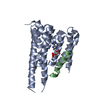 5f74S S: Starting model for refinement |
|---|---|
| Similar structure data |
- Links
Links
- Assembly
Assembly
| Deposited unit | 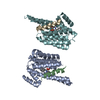
| ||||||||
|---|---|---|---|---|---|---|---|---|---|
| 1 | 
| ||||||||
| Unit cell |
|
- Components
Components
| #1: Protein | Mass: 26348.631 Da / Num. of mol.: 1 Source method: isolated from a genetically manipulated source Source: (gene. exp.)  Homo sapiens (human) / Gene: YWHAB / Production host: Homo sapiens (human) / Gene: YWHAB / Production host:  | ||||||||
|---|---|---|---|---|---|---|---|---|---|
| #2: Protein/peptide | Mass: 2768.206 Da / Num. of mol.: 2 / Source method: obtained synthetically / Source: (synth.)  Homo sapiens (human) / References: UniProt: Q9NP71 Homo sapiens (human) / References: UniProt: Q9NP71#3: Protein | | Mass: 26580.928 Da / Num. of mol.: 1 Source method: isolated from a genetically manipulated source Source: (gene. exp.)  Homo sapiens (human) / Gene: YWHAB / Production host: Homo sapiens (human) / Gene: YWHAB / Production host:  #4: Chemical | #5: Water | ChemComp-HOH / | Has ligand of interest | Y | |
-Experimental details
-Experiment
| Experiment | Method:  X-RAY DIFFRACTION / Number of used crystals: 1 X-RAY DIFFRACTION / Number of used crystals: 1 |
|---|
- Sample preparation
Sample preparation
| Crystal | Density Matthews: 2.55 Å3/Da / Density % sol: 51.81 % |
|---|---|
| Crystal grow | Temperature: 295 K / Method: vapor diffusion, hanging drop Details: 0.1M HEPES (pH 7.1), 30% MPD, 1% PEG 4000, 0.1 M Ni(II)Cl 6H2O |
-Data collection
| Diffraction | Mean temperature: 100 K / Serial crystal experiment: N |
|---|---|
| Diffraction source | Source:  SYNCHROTRON / Site: SYNCHROTRON / Site:  PETRA III, DESY PETRA III, DESY  / Beamline: P11 / Wavelength: 1.0332 Å / Beamline: P11 / Wavelength: 1.0332 Å |
| Detector | Type: DECTRIS PILATUS 6M-F / Detector: PIXEL / Date: May 18, 2018 |
| Radiation | Protocol: SINGLE WAVELENGTH / Monochromatic (M) / Laue (L): M / Scattering type: x-ray |
| Radiation wavelength | Wavelength: 1.0332 Å / Relative weight: 1 |
| Reflection | Resolution: 2.07→57.3 Å / Num. obs: 35961 / % possible obs: 99.94 % / Redundancy: 50.51 % / CC1/2: 0.999 / Net I/σ(I): 14.8 |
| Reflection shell | Resolution: 2.07→2.14 Å / Num. unique obs: 3582 / CC1/2: 0.973 |
- Processing
Processing
| Software |
| ||||||||||||||||||||||||||||||||||||||||||||||||||||||||||||||||||||||||||||||||||||||||||||||||||
|---|---|---|---|---|---|---|---|---|---|---|---|---|---|---|---|---|---|---|---|---|---|---|---|---|---|---|---|---|---|---|---|---|---|---|---|---|---|---|---|---|---|---|---|---|---|---|---|---|---|---|---|---|---|---|---|---|---|---|---|---|---|---|---|---|---|---|---|---|---|---|---|---|---|---|---|---|---|---|---|---|---|---|---|---|---|---|---|---|---|---|---|---|---|---|---|---|---|---|---|
| Refinement | Method to determine structure:  MOLECULAR REPLACEMENT MOLECULAR REPLACEMENTStarting model: 5F74 Resolution: 2.07→57.3 Å / SU ML: 0.33 / Cross valid method: THROUGHOUT / σ(F): 1.36 / Phase error: 31.84
| ||||||||||||||||||||||||||||||||||||||||||||||||||||||||||||||||||||||||||||||||||||||||||||||||||
| Solvent computation | Shrinkage radii: 0.9 Å / VDW probe radii: 1.11 Å | ||||||||||||||||||||||||||||||||||||||||||||||||||||||||||||||||||||||||||||||||||||||||||||||||||
| Displacement parameters | Biso max: 285.45 Å2 / Biso mean: 77.4586 Å2 / Biso min: 34.51 Å2 | ||||||||||||||||||||||||||||||||||||||||||||||||||||||||||||||||||||||||||||||||||||||||||||||||||
| Refinement step | Cycle: final / Resolution: 2.07→57.3 Å
| ||||||||||||||||||||||||||||||||||||||||||||||||||||||||||||||||||||||||||||||||||||||||||||||||||
| LS refinement shell | Refine-ID: X-RAY DIFFRACTION / Rfactor Rfree error: 0 / Total num. of bins used: 13
|
 Movie
Movie Controller
Controller


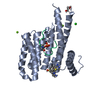
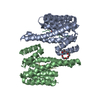
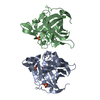
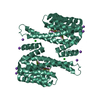

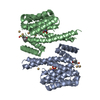

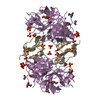
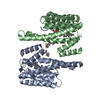
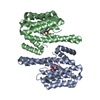
 PDBj
PDBj
















